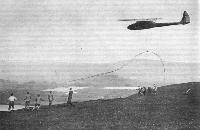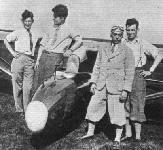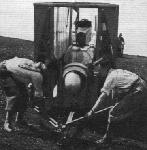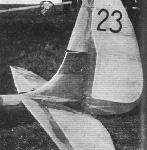
Варианты
- Lippisch / RRG - Professor - 1928 - Германия
- Lippisch / RRG - Wien - 1929 - Германия
M.Simons The World's Vintage Sailplanes 1908-45
THE WIEN
Late one June Sunday afternoon in 1930, a solitary figure walking quietly in the fading light on the chalk downlands of southern England, was startled by an apparently detached voice calling to him, “Where’s Portsmouth?”. He turned round and round but saw nothing until on hearing the voice again, he discovered above him a huge, but almost silent, flying machine, floating slowly by only a few score metres up. It had long, slender wings covered with pale yellow, translucent fabric, doped and varnished to glisten in the late sun. The fuselage was a thin cigar of polished wood, there was a diminutive tail unit and the pilot’s head, helmeted and goggled, was turned toward him. The man could have seen nothing like it before, unless he had travelled in Germany. Next day he would have read in his daily paper that the great German glider pilot, Robert Kronfeld, had on that Sunday made the first respectable cross-country soaring flight in England. Starting from Itford Hill near Beachy Head he had landed on Portsdown Hill close to Portsmouth at 8.30 pm, after soaring along the north-facing slopes of the Downs for a distance of 80 km.
It was not much to Kronfeld, who held the world distance record of 150 km and was to break it again later in the same year. The same pilot and aircraft held the height record of 2560 metres and had dominated the Rhoen competitions of 1929 and 1930. On June 20 1931, Kronfeld and the Wien even flew across the English Channel, in both directions, the first time this was done by glider though Kronfeld had a high towed start on each side before simply gliding over the water.
Kronfeld had the Wien built because he felt the need for a sailplane superior to any of the others then in use. The design was by Alexander Lippisch and the craft made its debut in 1929. After a few practice flights, Kronfeld in May became the first glider pilot to exceed 100 km, soaring along the famous but only 100 metres high ridge of the Teutoburger Wald in North Germany. Lift from clouds carried him across the occasional gaps but sometimes he was forced so low that he was level with the chimneys on the lower slopes. Near the immense monument to the ancient hero, Hermann (Arminius) who defeated the Roman legions there, Kronfeld was preparing to land in the trees but was saved at the last moment by a weak thermal and he passed the monument exactly level with the hero’s upraised sword. Using every fold of the slopes, he was now followed by a procession of gaping motorists who, as he finally slid to a halt in a ploughed field, surrounded him and his aircraft to shower him with congratulations. A little while later he accepted the cash prize for the first 100 km soaring flight, which had been offered by a newspaper. On other occasions Kronfeld flew in and above clouds and thunderstorms.
The Wien was named after Kronfeld’s native city, Vienna. The machine spanned 19.1 metres and the aspect ratio of the wing was a little under 20. To save weight and maintain stiffness, Lippisch braced the structure with large ‘V’ struts, in spite of the extra drag these caused. The Wien was in all respects safe and strong, yet was lightly loaded and pleasant to fly. The aerofoil was the Goettingen 549 which was to become very popular some years later. Lippisch increased its camber slightly for the Wien, concentrating on low-speed performance.
There was no windscreen so the pilot needed to wear goggles and helmet. Behind his head was the long, tapering fairing ahead of the wing pylon. Kronfeld now had his instruments, especially the all-important and once-secret variometer, mounted face-upward on the rounded decking just in front of the cockpit opening. The elevator was of the all-moving type without any trimming device or balance weights. The fin was small, being no more than a stub for mounting the large, balanced rudder. Landings were made on the usual rubber sprung skid. For road transport the wing could be dismantled into three parts, consisting of a rectangular centre section of about five metres length, and tapering tip panels, each seven metres long and carrying the ailerons.
The most significant of all the great flights made by Kronfeld in the Wien, was on 5th August 1931. No record was broken, the 164 km distance being the same as that achieved the previous year by the same aircraft, but Georgii wrote at the time, “this flight offered the first important scientific information about the frequency of ascending convection currents. They are apparently so plentiful if the weather is favorable and the sailplane has enough altitude, that a short gliding flight leads again to an effective upwind zone.” Glider pilots could now confidently turn away from the slopes, for on good summer days there would be thermals waiting.
Kronfeld’s exploits in the Wien, even more than his 1928 flights in the Professor, marked a new era in soaring. It soon became clear that a different sort of sailplane would be needed for cross-country flying over the plains. It was still most important to have a low minimum sinking speed for many upcurrents were known to be feeble. To cover worthwhile distances it was necessary to fly across the gaps between the thermals, so a fine glide ratio was vital to avoid excessive loss of height.
Technical data:
Wien: Span. 19.10m. Wing area. 18.6 sq m. Aspect ratio. 19.6. Empty weight, 158 kg. Flying weight, 248 kg. Wing loading, 13.8 kg/sq m. Aerofoil, Goettingen 549 (modified, with increased camber).
- M.Simons The World's Vintage Sailplanes 1908-45
Фотографии
-
GL / M.Simons - The World's Vintage Sailplanes 1908-45 /Kookaburra/
The Wien, piloted by Robert Kronfeld, during the tour of England made at the invitation of the newly-formed British Gliding Association in 1930.
-
Flight 1930-06 / Flight
BEAUTY: Two views of the Wien when in the air. The unpigmented dope used makes the wings almost transparent.
-
Flight 1933-10 / Flight
The Wien glider of M. Henry Lumiere, President of the Aero Club of Rhone and South West.
-
Flight 1930-02 / Flight
A PROFESSOR TYPE: The "Wien"
-
GL / M.Simons - The World's Vintage Sailplanes 1908-45 /Kookaburra/
The Wien being launched at the Wasserkuppe during the 1931 Rhoen meeting. Kronfeld had by then fitted a small windscreen.
-
Flight 1930-06 / Flight
WELL AWAY: The "Wien" just after being launched. The double cord which is used can be seen.
-
Flight 1930-06 / Flight
A GENTLE ONE: The Wien just landing. Herr Kronfeld's landings would not break the proverbial box of eggs.
-
GL / M.Simons - The World's Vintage Sailplanes 1908-45 /Kookaburra/
The Wien being prepared for a demonstration flight in England. Kronfeld is with the group beyond the starboard wing.
-
Flight 1930-06 / Flight
THE VISITORS: Herr Kronfeld has on his right his two friends Herren Flinsch and Ball and on his left is his mechanic Herr Pruhn
-
Flight 1931-07 / Flight
Herr Kronfeld in the Wien just before making his flight over Hanworth.
-
Flight 1930-09 / Flight
Herr Kronfeld, who is expected to be the winner of main competitions this year.
-
GL / M.Simons - The World's Vintage Sailplanes 1908-45 /Kookaburra/
Robert Kronfeld in the Wien in 1930. At this time Kronfeld flew without any windscreen, his three instruments being mounted face-up in the ’dog collar' cockpit canopy. The venturi was the pressure source for the airspeed indicator. The emblem above the strut end fitting was that of the Segelflugzeugbau Kassel. The quality of the high gloss varnish finish was typical of most high performance sailplanes.
-
Flight 1930-06 / Flight
The front end of the "Wien's" travelling crate.
-
Flight 1930-06 / Flight
A side view of the crate, ready for towing.
-
Flight 1930-06 / Flight
The "Wien" being assembled at Firle.
-
Flight 1930-06 / Flight
DETAIL: The careful fairing of the rudder can be seen by the celluloid strip which covers the gap at the post.
-
GL / M.Simons - The World's Vintage Sailplanes 1908-45 /Kookaburra/
A replica of Kronfeld's instrument layout on the Wien. The airspeed indicator, altimeter, and the all-important variometer were mounted face-up on the fuselage decking.
- Фотографии


















